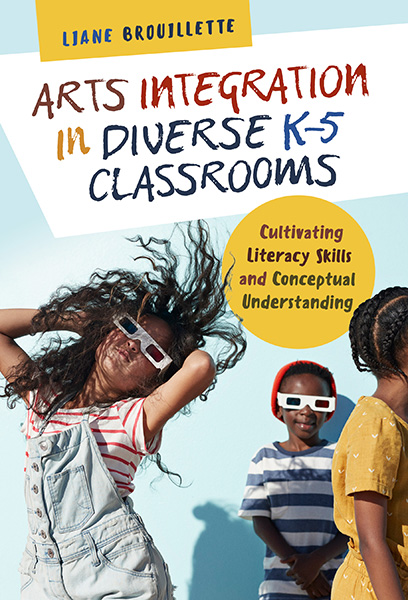Professors: Request an Exam Copy
Print copies available for US orders only. For orders outside the US, see our international distributors.
Publication Date: July 12, 2019
Pages: 160
Series: Language and Literacy Series

This practical resource emphasizes the special contribution that visual art, drama, music, and dance can make to student literacy and understanding of content area reading assignments. Focusing on those areas where students tend to struggle, this book helps K–5 teachers provide an age-appropriate curriculum that is accessible to an increasingly diverse student population but does not ignore other important aspects of healthy human development. Without detracting from the rigor of a demanding curriculum, Brouillette demonstrates how arts integration allows students to engage with concepts on their own developmental level. Each chapter focuses on a skill set that is fundamental to literacy development, suggests age-appropriate arts integration activities that will build that skill, and offers guidance for fostering a sense of community.
Book Features:
Liane Brouillette is a professor at the School of Education, University of California, Irvine and editor of the Journal for Learning Through the Arts.
“It is obvious that this book will be of great use to the classroom teacher looking to expand student success through the application of theoretically sound and practically successful arts integration strategies. It is also an important contribution to the general field of the arts in education.”
—Journal for Learning through the Arts, UC Irvine
“With a particular focus upon language literacy, the author depicted arts integration strategies found to enhance student performance by offering opportunities for meaning-making (learning to listen, speak, and interact with text) and effective expression (learning to communicate as speakers and writers). A strength of the book is that the author advocates for a co-equal cognitive form of integration where arts learning and language learning are equally emphasized within learning contexts. This emphasis is important because arts educators are understandably critical of approaches that place the arts in a subservient role, or of situations where the arts subjects are replaced by arts integration altogether. A strong arts curriculum is necessary to ensure that students develop high skill levels in each of the arts, a key to effective integration.”
—Teachers College Record
“Overall, Arts Integration in Diverse K–5 Classrooms: Cultivating Literacy Skills and Conceptual Understanding offers in- and pre-service teachers a rich platter of texts, activities, and lesson plans that integrate arts in literacy instruction.”
—Journal of Language and Literacy Education
"Arts Integration in Diverse K-5 Classrooms offers a thoughtful look into both theoretical and practical issues surrounding arts integration as a viable strategy for increasing students’ achievement and access to higher education and career pathways. This book is especially timely in the context of a widespread focus on equity and inclusion as teachers are facing more diversity in the classroom than ever before."
—Kristen Greer-Paglia, CEO, P.S. ARTS
“This book, offering a rich buffet of art-based activities grounded in critical ideas about teaching and learning, includes topics as oral language development, visual thinking strategies, making meaning of narrative and informational texts, and expression through narrative and informational writing. An excellent guide to teachers aspiring to integrate the arts into their curriculum, it is both a delightful and useful read."
—Liora Bresler, University of Illinois, Champaign-Urbana
Contents
1. Deepening Understanding Through Arts Integration 1
Understanding Arts Integration 1
Benefits of Comprehensive Education 5
2. Making Meaning Through Verbal Interaction : Laying the Foundation for Literacy 11
The Critical Importance of Oral Language Development 12
Supporting English Language Learners 15
Integrating Drama and Dance Activities 19
Visual Thinking Strategies 23
3. Making Meaning of Narrative Text 27
How Written Narrative Influences Thinking 28
Deepening Children’s Understanding of Narrative 32
Classic Story Structures 42
4. Making Meaning from Informational Texts 45
Using the Arts to Teach Close Reading 46
Meeting the Challenges of Content Area Texts 48
Using the Arts to Scaffold Science Lessons 52
A Crucial Dimension of STEAM 57
5. Building Effective Oral Communication Skills 59
Learning Oral Communication Skills Through Puppetry 60
Introducing Children to Social Studies 61
How Music Builds Rapport 66
Viewing the Past from Multiple Perspectives 71
Introducing Varied Perspectives in K–5 Social Studies 74
6. Expression Through Narrative Writing 77
Combining Images and Writing in the Primary Grades 78
Images as Inspiration for Writing 78
Using Memories for Inspiration Within Classrooms 84
The Poets of El Sol Academy 85
Writing Stories from Personal Experience 89
Skills-Based Gains in Student Writing Abilities 91
7. Expression Through Informational and Persuasive Writing 95
Teaching Writing Through the Arts 97
Responding to Literature 99
8. Building Executive Function Skills with Arts Activities 107
What Is Executive Function? 107
Evidence from Research 111
9. Bringing the Arts Back to the Language Arts 121
Choosing Arts-Based Activities That Reinforce Learning 122
Exploring Human Relationships Through Stories 123
Teaching Abstract Concepts to Concrete Thinkers 124
The Acquisition of Narrative Skills 125
Making Connections and Revealing Underlying Structure 126
Enhancing Executive Function 127
Arts Integration Versus Transfer 128
References 131
Index 143
About the Author 154
Professors: Request an Exam Copy
Print copies available for US orders only. For orders outside the US, see our international distributors.